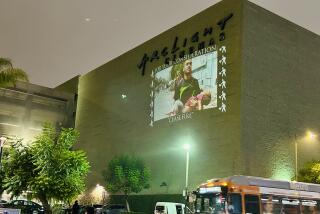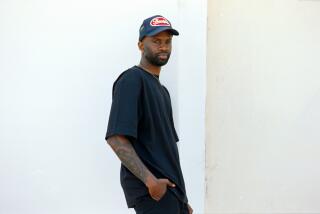NYC Screen Has the Corner on Earnest Images
NEW YORK — It’s a lot to ask a New Yorker -- to slow down, look up and thoughtfully observe. Especially around Times Square, the eyes are so aroused by so many fast-moving images that it’s difficult to absorb any one of them. But this month a digital billboard at West 42nd Street and 8th Avenue has offered passersby a classy eyeful. And some have even stopped to look.
Images from the archive of Magnum Photos, the famed collective of photojournalists, have flashed 6 seconds at a time, across a 1,300-square-foot screen that wraps around the northeast corner of the Port Authority bus terminal.
Two weeks ago, the billboard honored the birthday of the late civil rights leader Martin Luther King Jr. Filmmaker Spike Lee and his photographer brother, David, compiled the images from the Magnum archive. Many were iconic -- of King, Rosa Parks, Malcolm X, African American children plowing fields or confronting police. They relayed a candor emblematic of the elite agency that for five decades has been owned by its photographer-members. Last week a series dedicated to “silence” began running in a constant, 10-minute loop in this not-very-quiet corner of New York.
“We tried for anti-iconic for this series, where it might be light or a gesture or a detail that has captured the photographer to create an image that sings in a special way,” said Susan Meiselas, a Magnum photographer who with colleague Alex Webb curated this part of the billboard exhibit. Finishing out the month is an exhibition focusing on war, depicting through images, and quotes from soldiers and civilians, the role that the U.S. has played in Iraq.
In addition to photos drawn from the agency’s million-image archive, embedded Magnum photographer Thomas Dworzak sent live reports via satellite from Baghdad and Mosul. Most of the people who rushed down 42nd Street one recent morning were so busy bracing against the cold that they seemed unaware of the artistic offerings on the screen ahead of them. However, Larry Dillon, perhaps because he was an out-of-towner, took a few extra minutes to stop and look up.
“I noticed,” said Dillon, a San Francisco restaurateur, “mostly because I saw high-quality images. They stood out among all the cheaper stuff.” Right then a photograph of a young, smiling King flashed across the billboard. Dillon looked at the image and at the surrounding advertisements in Times Square and said he found it amazing that there was something in this place that wasn’t selling something.
In fact, the owner of the billboard, SmartSign Media, had this space open for January and wanted to present some culture where there is pure commercialism. The three-story billboard, which usually costs $300,000 to rent for a month, was offered free to the photography collective, said Mark Lubell, who became director of Magnum’s New York bureau about a year ago.
He said the exhibit fit with a larger goal of the collective to expand the “brand” of Magnum, which was founded in 1947 after a series of conversations in a Paris cafe among four friends -- Henri Cartier-Bresson, Robert Capa, David Seymour and George Rodger.
The photojournalists’ original vision was to create an agency that would give photographers from all over the world independence, enabling them to represent their own point of view.
But over five decades, with the shrinking of its original client base -- magazines like Look and Life dedicated to photojournalism -- Magnum has been looking for new sources of revenue and new outlets for its 34 active members with their lofty ideals and developed tastes.
After SmartSign made the offer, Lubell launched an e-mail to members asking them to select three favorite images from the archives for the first exhibit. Most were black and white. The next series, mostly in color, was curated by two young Magnum war photographers. Next came a series titled “New York, My Town” put together by Bruce Gilden and including several images by Eve Arnold.
The entire exhibit also has been running on the Internet at magnuminmotion.com. That alone has reached 40,000 people. What’s unclear is how many of the 1.5 million people who have passed by every day have taken the time to absorb the story being told in the photographs. “It’s definitely nice in Times Square to see something amid the commercial nonsense that reminds you about American history,” said Sasha Vajd, a student from Slovenia who is studying here for a semester and came to see the billboard after she heard about it from a friend. “It helps in a place like this to see something that makes you feel human.”
More to Read
The biggest entertainment stories
Get our big stories about Hollywood, film, television, music, arts, culture and more right in your inbox as soon as they publish.
You may occasionally receive promotional content from the Los Angeles Times.










